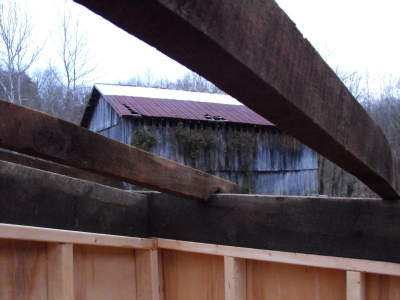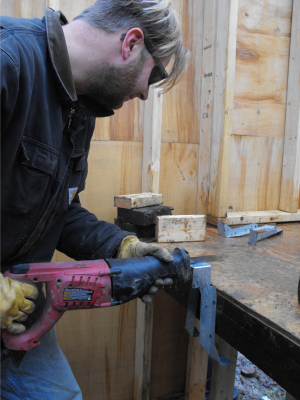
Advantages and disadvantages of scavenged lumber
 As
we reach the rafters of the homemade
storage building,
we're using primarily scavenged lumber and are discovering that it has
its pros and cons.
As
we reach the rafters of the homemade
storage building,
we're using primarily scavenged lumber and are discovering that it has
its pros and cons.
On the pro side, that
old wood is hard --- Mark screws straight
into storebought lumber as if it's balsa wood, but our scavenged boards
require pilot holes. The scavenged lumber also comes in much
thicker sections --- no 1.5 inch lumber here. From a very
project-specific standpoint, the scavenged wood makes awesome rafters
because it's already cut to the length of the tin (that we plan to
reuse) and has a handy notch in just the right place.
 On
the other hand, scavenged lumber isn't quite so modular as those
regular 2X4s. We've had to add a spacer here and there since some
rafters are thicker than others. Furthermore, the brackets that
Mark found in the barn to secure the non-notched ends of the rafters to
the header would have fit 2X4s but not our old rafters. Luckily,
Mark was able to cut the brackets in half and they worked just fine.
On
the other hand, scavenged lumber isn't quite so modular as those
regular 2X4s. We've had to add a spacer here and there since some
rafters are thicker than others. Furthermore, the brackets that
Mark found in the barn to secure the non-notched ends of the rafters to
the header would have fit 2X4s but not our old rafters. Luckily,
Mark was able to cut the brackets in half and they worked just fine.
Of course, you all know
my main motivation in using scavenged lumber --- price. It's hard
to beat free, especially since it doesn't take any longer to tear the
boards out of the old building than it would take to drive to the
nearest big box store. You sure do buy less when you live in the
middle of nowhere.
| This post is part of our Building a Storage Building from Scratch
series.
Read all of the entries: Part 1: Foundation
Part 3: Walls and scavenging lumber
Part 5: The roof
|
Want more in-depth information? Browse through our books.
Or explore more posts by date or by subject.
About us: Anna Hess and Mark Hamilton spent over a decade living self-sufficiently in the mountains of Virginia before moving north to start over from scratch in the foothills of Ohio. They've experimented with permaculture, no-till gardening, trailersteading, home-based microbusinesses and much more, writing about their adventures in both blogs and books.
Want to be notified when new comments are posted on this page? Click on the RSS button after you add a comment to subscribe to the comment feed, or simply check the box beside "email replies to me" while writing your comment.
- Remove comment
- Remove comment
